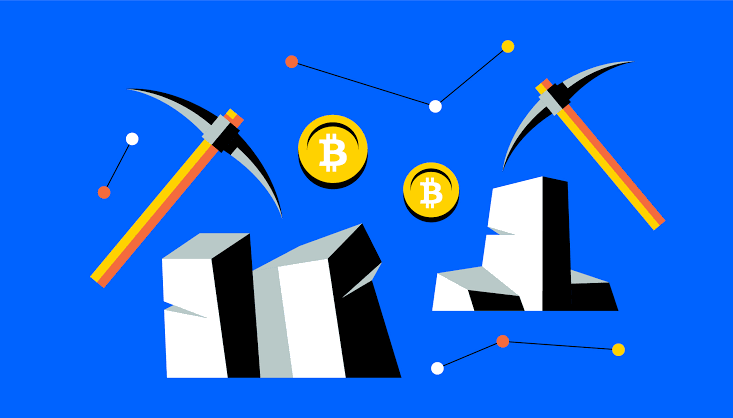Today, the crypto market has grown remarkably, gaining global recognition and widespread adoption. The industry ranks as one of the leading economies in the world. One of the major rudiments of cryptocurrencies is mining. It is worthy of note that crypto mining is quite different from the mining everyone is used to. In general parlance, mining has to do with digging the earth to acquire treasures. It entails a complex process, requiring participants to harness explosives in blasting the hard surfaces. This thus means mining requires heavy-duty technologies and a good number of labour.
You can read more about the uniqueness of the crypto market by clicking here.
However, crypto mining is very different. This is because crypto is a digital asset and does not have any physical representation. It is therefore impossible to unearth such assets with explosives and heavy-duty machines. Beginners will then start to wonder how crypto mining is done since it has been distinguished from the known form of mining. This article will provide an answer to that succinctly.
What is Crypto Mining?
Crypto mining deals with the process through which cryptocurrencies, including Bitcoin generate new coins. While crypto mining is different from the general mining, it is not in doubt that both are geared towards achieving the same purpose. Every form of mining seeks to discover and acquire new treasures. Certainly, crypto mining is not an exception. However, in the case of crypto, it employs a huge, decentralized network of computers to verify and secure transactions on the blockchain network. As a reward for the efforts towards securing the network, miners are usually rewarded with new coins. Thus, we can say that the new coins serve as the incentive for miners working round the clock to keep the blockchain network running.
It must be noted that not all crypto assets can be mined. This is due to their design. Cryptocurrencies that are mineable usually use proof-of-work (PoW) consensus mechanisms to create new blocks on the network. Accordingly, some of the mineable cryptocurrencies are Bitcoin, Dogecoin, Monero and many more. According to findings, there are more POW cryptocurrencies in the market, constituting over 63%.
To read more about proof-of-work and how it differs from proof-of-stake, click here.

The Proof of Work consensus mechanism is critical to crypto mining. It is simply an initiative that advocates an appreciable percentage of responsibility in a bid to avert hacking, network jamming, spam emails and many more. The mechanism mandates miners to secure the blockchain network by solving notable calculations, thereby getting new tokens as reward. The initiative came into the limelight in 2004 through HaI Finney. He believed digital wealth can be built through “reusable proof of work” using the SHA-256 hashing algorithm. It is noteworthy that any crypto using PoW is usually able to process peer-to-peer transactions without any intermediary.
How does Crypto Mining Work?
Mining of cryptocurrencies necessitates the use of decentralized supercomputers to verify new transactions. This thus birth the production of new crypto assets. By verifying transactions, the connected supercomputers are protecting the blockchain network. Mining Bitcoin for instance is quite similar to running a data collection syndicate. According to findings, the large collection of connected supercomputers enable mining firms to make 63 digit hexadecimal speculation. This thus forms its output calculations in “Hash.” The first supercomputer to get the correct digit wins the new crypto incentive, thereby incorporating the figure in the blockchain record.
Generally, crypto mining consumes a large amount of electricity. This is why some countries today have chosen to ban it. Apart from the fact that it requires a huge power supply to power the supercomputers, the vast resources needed to sustain crypto mining is usually expensive. However, it must be noted that crypto mining won’t manifest forever. Bitcoin for instance has a maximum supply of 21 million coins.
To know if Bitcoin is a good investment for you, it is recommended that you read this article.
Certainly. there won’t be more than 21 million BTC. This is done to enhance the performance of the token. According to our findings, Bitcoin mining is likely to reach its maximum by 2140. By virtue of this, rewards given to miners will start reducing until there is no BTC to mine. When this happens, miners will now have to depend on transaction fees paid by users of the network as their incentives and not new coins.
Over the years, there have been a lot of debates over the status of miners. While some argued that the organizations which engage in crypto mining activities should be regarded as miners, others feel the ASIC mining chips or supercomputers deserve the status. However, it is safe to refer to the chips as miners because they engage directly in solving the numerous mathematical calculations to verify transactions, thereby mining new coins. Notwithstanding, we can also call organizations, individuals and others engaging in mining activity miners.
You can also read about how you can singlehandedly calculate your crypto taxes here.
Conclusion on Crypto Mining
It has been established that crypto mining is essential to secure, power and fuel a blockchain network. For these rigorous efforts, miners are rewarded with new tokens. However, for the purpose of enhancing the performance of mineable crypto, there is usually a limit or maximum supply. When a crypto reaches its maximum, miners won’t be able to get new coins as incentives again.
Meanwhile, several researches have been done in recent years as regards crypto mining and its implication on energy grid. The most recent one was carried out by American’s largest university, Texas A&M. Findings from the research show that Bitcoin mining can help stabilize the energy grid.




















